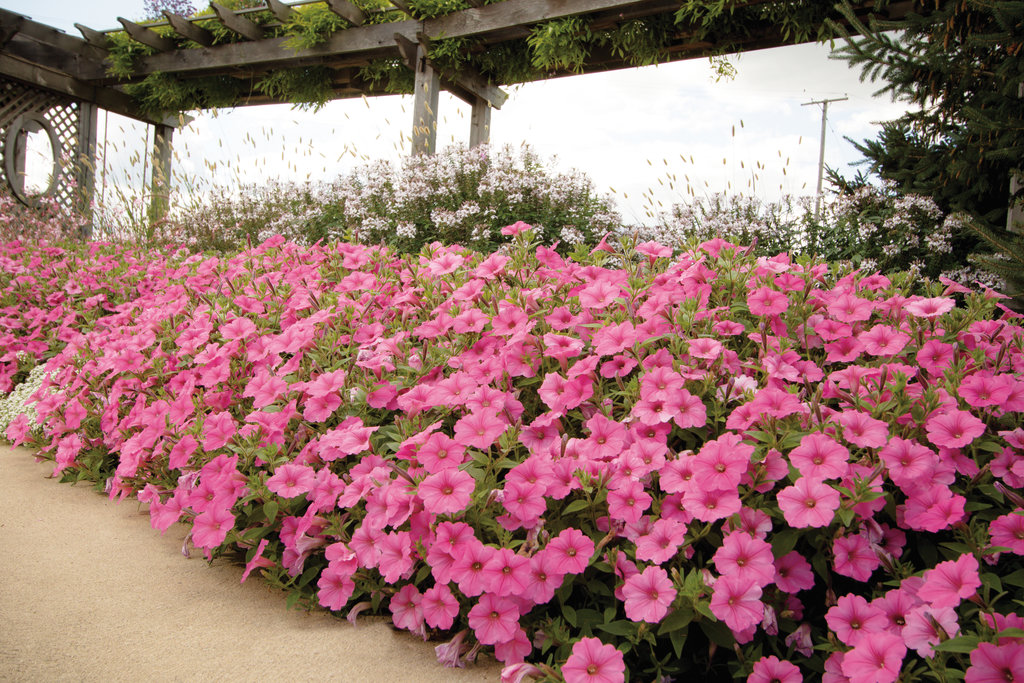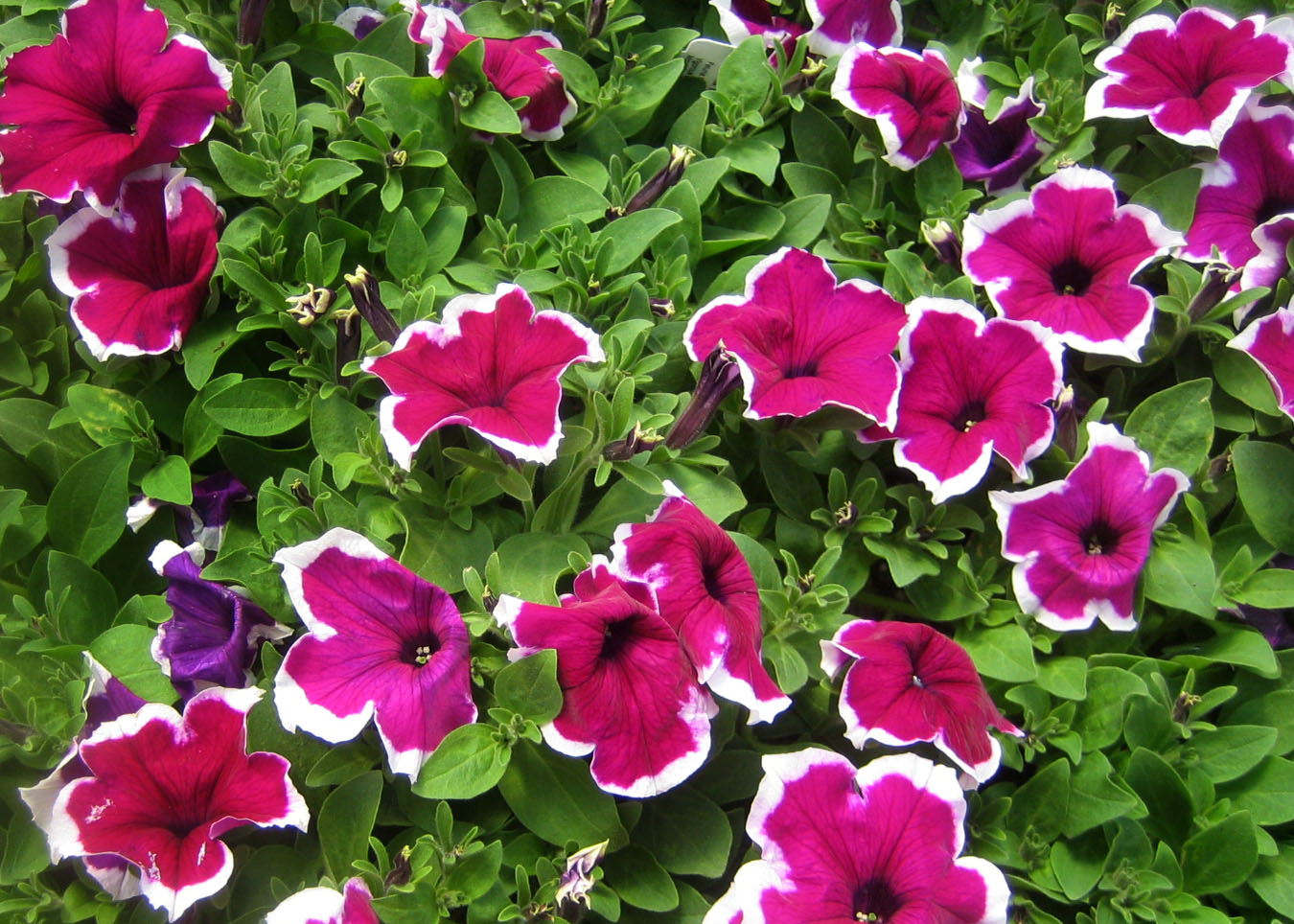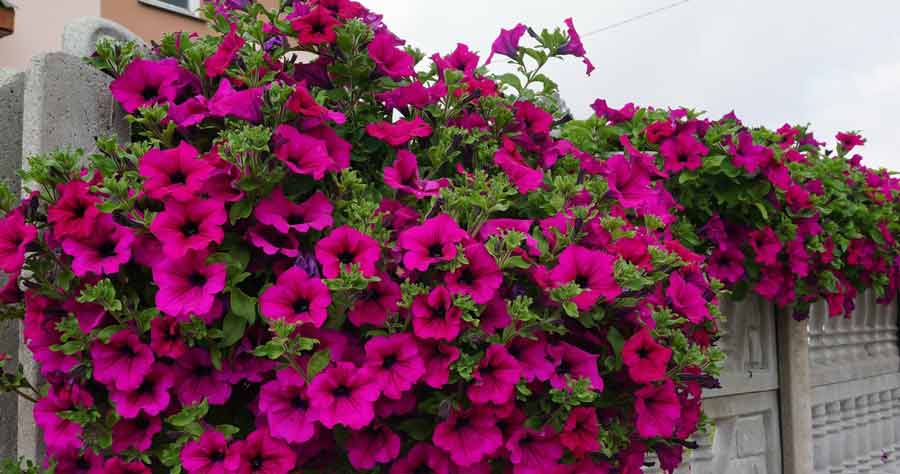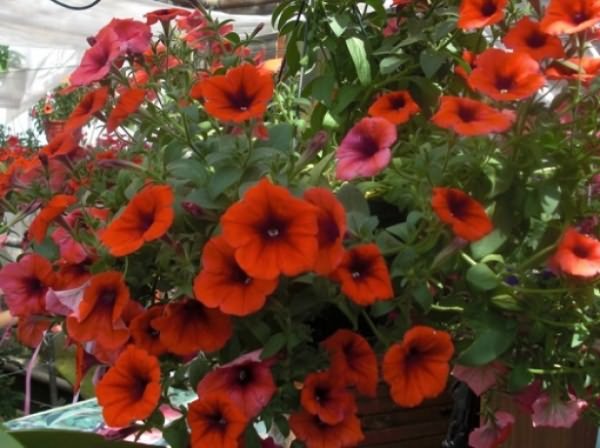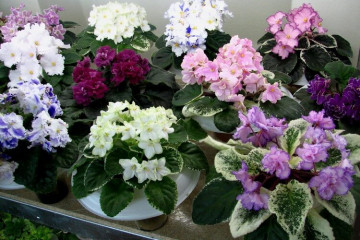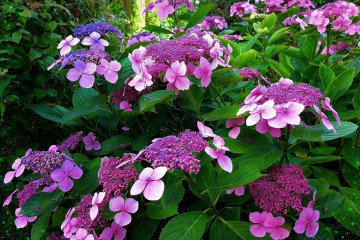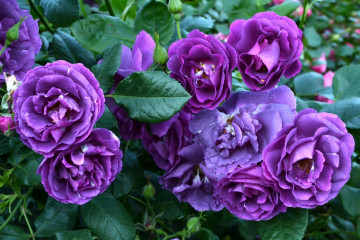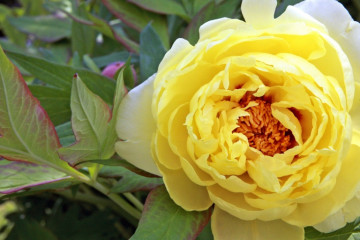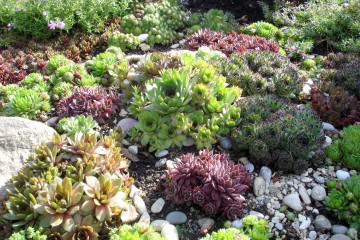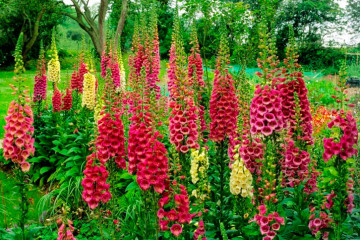Bush petunia - the best varieties for open ground
Content:
Shrub petunia is considered a popular plant that is often grown in the garden of flower growers. The abundance of varieties allows you to choose flowers, the shape and shade of which will correspond to the preferences of the owner of the site. Flowers can be grown not only in flower beds, but also in pots or hanging pots. The plant is often used by landscape designers when landscaping the local area. The varieties of petunias presented below will help each grower choose the most suitable variety for themselves.
What does bush petunia look like?
Petunia is a prominent representative of the Solanaceae family. The semi-shrub perennial appeared in South America. The main feature of bush varieties of ornamental culture is considered an abundance of varieties and a bright, lush flowering. The shoots of the annual are green. The root system is shallow. Petunia stems are erect, and each shoot and leaf plates are abundantly covered with villi. The diameter of the flowers reaches 12-16 cm, depending on the variety. The inflorescences can combine a pair of funnel-like flowers. Pedicel length is insignificant. The transition of shades is soft, gradient. The extreme parts of the flowers can be not only even, but also wavy, corrugated. After the plants have faded, seed pods will form on them.
The color scheme of petunias can be varied:
- purple;
- pink;
- black;
- snow-white;
- purple;
- red, etc.
Blue petunia is best planted in combination with bushes that bloom with white buds.
Ornamental culture does not need the formation of bushes. The most important thing is to pinch and trim in a timely manner.
History of appearance
The birthplace of bush petunias is the territory of South America. The first such plants were discovered in the 18th century. For some time, botanists have classified the ornamental culture as belonging to the genus Nicotiana (Tobacco). In the tropical regions of America, several more plant species have been found. In the 19th century, breeders decided to combine ornamental crops into a separate category called Petunia.
Hybrid plant varieties were obtained after breeders managed to successfully cross different types of petunias. After the end of World War II, container technologies for growing seedlings were established in the United States. The hybrids were labeled F1: it is convenient to grow such varieties in pots.
Classification of popular types of spray petunias
What is petunia? An annual crop, depending on the variety, differs in the nature of flowering, the shade of flowers and their dimensional characteristics. Bush petunia is divided into several subgroups:
- Milliflora. The bushes belonging to this subgroup are compact in size. The diameter of the flowers is in the range of 2-4 cm. Small petunia tolerates a prolonged rainy period.
- Multiflora.Low-growing petunia is ideal for planting in small flower beds. The diameter of the flowers reaches 5-7 cm.
- Grandiflora. A variety of large-flowered petunia, the diameter of flowers of which exceeds 14-15 cm. The outer parts of the flowers can be corrugated, fringed, wavy. There are two-color varieties in this group of plants.
- Floribundu. Petunia of this subgroup is distinguished by abundant flowering. A plant with large flowers tolerates unfavorable weather. Annual crops are often planted in elongated balcony pots and large-scale flower beds. Spotted petunia looks most impressive.
The cultivars that are most popular with horticulturists
There are a huge number of varieties of annual crops. Below you can see the varieties of the most beautiful petunias.
Daddy
The inflorescences of the variety are large. Daddy blooms plentiful. The height of the bushes does not exceed 20-25 cm. The variety tolerates unfavorable weather conditions. However, it is possible to achieve abundant and long-lasting flowering only when growing an annual in an area with diffused lighting, which is reliably protected from drafts.
It is best to plant this variety with a climbing petunia. Flowers, which bloom on the bushes at the end of May, are painted in pink, scarlet, blue and white palettes.
Pikoti
During the flowering of the Pikoti variety, large inflorescences of various shades form on its bushes. The petals are distinguished by the presence of a white border. Such a culture is quite unpretentious to climatic conditions, calmly withstands high humidity, rains. The height of the bushes can reach 20-25 cm. The flowering of Pikoti petunia lasts from early June to mid-September. To grow them, you should take spacious flowerpots.
Storm
The Storm variety is not affected by wind and moisture. The shape of the inflorescences is round. The flowers are large enough. Petunia is resistant to various ailments. A prolonged rainy period will not affect the duration and abundance of flowering. The height of the bushes exceeds 30 cm. Flowers can be painted in white, purple, blue and red colors. Blue petunia looks especially impressive when planted with perennial bushes that bloom in white.
Polaris
The hybrid variety is resistant to a variety of ailments. The flowering period covers the whole summer. The height of the bushes reaches 25-30 cm. Petunia of this variety can be planted not only in flowerpots, but also in open ground.
Dreamms
The large-flowered hybrid is compact in size, despite the abundance of richly developed branches. The diameter of the inflorescences, from which a pleasant aroma emanates, reaches 12-13 cm. Landscape designers often use the Dreamms variety when landscaping a site.
Fantasy
Variety Fantazia steadily tolerates temperature extremes. The development period of the plant is short. The flowering period lasts from late May to mid September. The wave-like shape of bright colors will effectively decorate any flower bed.
Hit parade
Neat annuals are distinguished by early flowering. The formation of inflorescences begins at the beginning of May. The leaf plates are small. Inflorescences can be painted in lilac, blue, blue and purple tones.
Titanium
Bushes, the diameter of which reaches 40-45 cm, erect. A large number of branches are formed on them. The height of the bushes is in the range of 25-30 cm. Oval leaf plates of a light shade are rather large in size. The flowers are colored pink. The outer parts of the flowers are fringed. In the central part, the inflorescences are colored beige.
Triumph
The multi-flowered variety is quite sensitive to a prolonged rainy season.
The striped corrugated petals in the central part are painted in darker colors. The diameter of the flowers reaches 16 cm.
Limbo
Petunia (the Latin name for an annual) of the Limbo variety is distinguished by abundant and long flowering. The bushes of this variety are undersized. The diameter of the inflorescences, colored in peach, purple, pink, silvery, white and purple shades, reaches 12-14 cm.
Rare varieties
The following varieties of petunias are considered quite rare:
- Black Velvet. A variety that belongs to the grandiflora subgroup. The variety was bred not so long ago by British breeders. Large bells are painted in black tones. It is best to plant these flowers in pots.
- Table Yellow. Ampelous alpine petunia, inflorescences of which are painted in lemon colors. You can see bright yellow streaks on them. The height of the bush reaches 25 cm.The diameter of the buds is within 10-12 cm.
Features of care in the garden
In order for petunia to please with abundant and bright flowering, it is very important to properly care for it. Below you can find information on the features of caring for an ornamental crop.
Watering
After planting annual plants, you should systematically moisten the soil in the flower bed. Do not allow excessive soil moisture, which leads to waterlogging of the land. Against this background, the root system of plants will begin to rot. The soil moistening procedure should be carried out in the morning and evening hours.
During prolonged torrential rains, you should move the hanging pots indoors, since the roots of the plant will begin to rot against the background of excessive moisture. When watering petunias, pour water directly under the bush. When it gets on the petals, the latter will look disheveled and lose their decorative appearance.
Top dressing of bushes
Petunias need systematic feeding. It is recommended to apply organic matter, humate and mineral fertilizers every 5-7 days. Timely application of top dressing will have a positive effect on the development of the vegetative mass of the bushes.
Pruning
Bush petunia needs systematic pruning, which helps to increase the bushiness of the ornamental culture. Ampel and cascade varieties of ground cover plants do not respond to pruning: the bushes continue to grow in one lash.
Seed collection
After the seed pod is ripe, it will open and the seed will begin to scatter around the mother plant. That is why experts recommend collecting seeds at the moment when the capsules reach a semi-ripe state. To do this, they are cut from flowers and laid out in bags that need to be stored in a room where the temperature reaches 18-22 degrees. During the winter, the boxes will ripen and open. Seed germination lasts 2-3 years.
Flowering features
Petunia inflorescences are tender. Even gusts of strong wind can damage them. It is very important to bring hanging pots indoors during heavy rain. If it is not possible to transfer the flowers, then after the rain, damaged inflorescences can be plucked from the bushes, which spoil the appearance of the plants. After 3-4 days, new buds will form on the bushes. Petunia flowers can be painted in various shades:
- white;
- blue;
- black;
- red;
- purple;
- blue;
- pink;
- purple, etc.
Yellow petunia looks especially impressive in a flower bed.
Pedicels are rather short.The shape of the flowers is funnel-shaped with the presence of bells expanding to the top, located in the axils of the green mass of plants. The diameter of the corollas, depending on the variety, can reach 5-16 cm. The flower is formed from five smooth or folded petals fused together. The extreme parts of the petals can be either smooth or corrugated, wavy.
Changes in care during flowering
During the flowering period, the plant needs good sunlight. It is important to water the flowers abundantly by pouring water directly under the bush. In the event of prolonged torrential rains, plants begin to suffer from a deficiency of useful elements, which are washed out by rains from the ground. Flowers against this background become smaller. In some cases, petals may fall off.
During the flowering period, it is recommended to apply mineral fertilizers to the soil. The soil in the flowerbed must be loosened every 5-6 days.
Possible growing problems
Various problems can arise when growing a ground cover plant. Bush petunia can be affected by diseases of the type:
- Black leg, affecting the stem part, which is covered with a black bloom. This disease often damages the seedlings. Sick bushes cannot be cured.
- Brown spot that occurs against the background of an increased level of air humidity. The causative agent of the disease is a fungus. To cope with brown spot, it is recommended to use preparations that include copper. Processing is carried out every 7 days for a month.
- Powdery mildew, which occurs against the background of waterlogging of the soil and sudden changes in temperature. Leaf plates and stems of diseased bushes are covered with a bloom of white. To cope with the disease, it is advised to use drugs like Fundazol and Topaz.
In addition to diseases, insects can harm petunias. Below you can find the most common pests of bush annuals:
- Whitefly, the body of which is covered with powdery pollen. Insects drink the sap of the plant, which can lead to the death of the bushes. To cope with an insect, you will need to use "Confidor" and "Aktelit".
- Aphids, covering the stems of flowers with a dense layer, leads to wilting and twisting of leaf plates, the death of bushes. In order to combat insects, it is advised to use "Decis" and "Confidor".
- Spider mites destroy annuals in a short period of time. Pests can be detected by a thin cobweb that forms on flowers. It is important to treat ground cover plants with "Demitan", "Neoron" as soon as possible.
In cases of improper care, disruptions in the development of decorative culture may occur:
- stretching of the stems and slight flowering indicate inadequate lighting or inappropriate temperature;
- loss of decorative qualities can occur against the background of disheveled inflorescences, which are important to remove from the bush if damaged;
- the defeat of petunia with a fungal disease indicates a lack of useful elements that can be replenished by systematic introduction of humus into the soil.
Use in landscape design
Petunia is an unpretentious plant that is often used by landscape designers in the process of landscaping the local area. The bushes are effectively used when grown in:
- rockeries;
- alpine slides;
- mixborders;
- rectangular flower beds;
- vertical beds;
- hanging pots.
Petunia looks amazing when disembarking in the alpine slides. Unpretentiousness of plants, abundant and long flowering are significant advantages of ornamental culture. By turning on your imagination, you can create many original compositions on your site.
